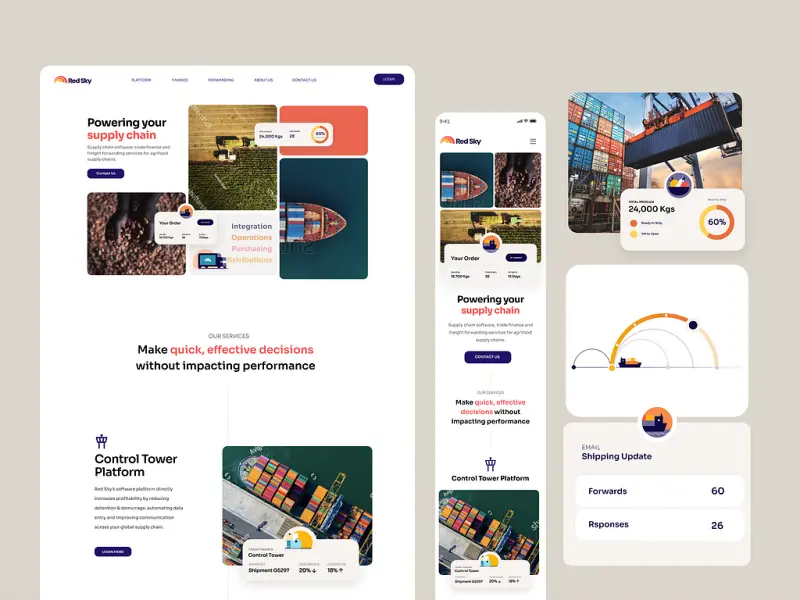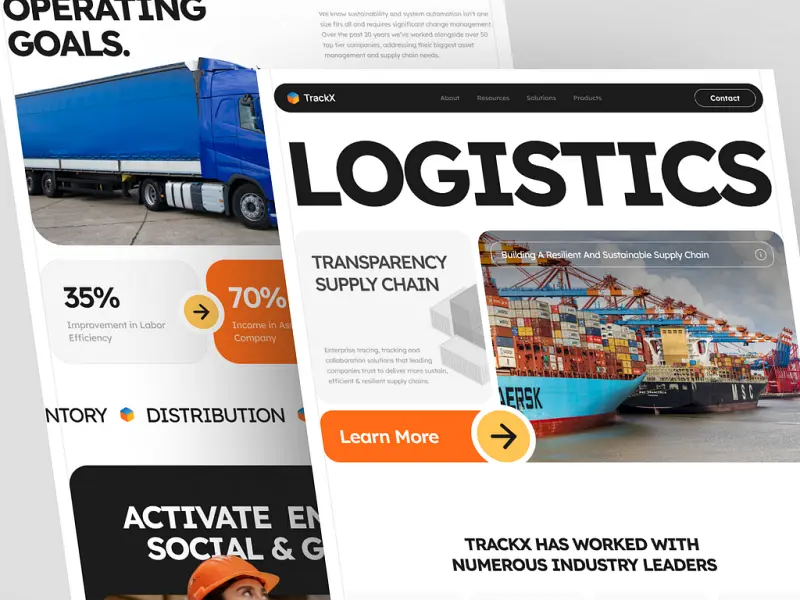Must Read Guide for Your Supply Chain Software Development
- TECHVIFY Team
- 0 Comments
An efficient supply chain is essential for a successful business, but traditional methods reliant on human labor are often slow and error-prone. Advanced software is now crucial in supply chain management (SCM), ensuring smooth product movement from manufacturing to distribution.
With supply chain software from experienced vendors, businesses can accelerate tasks and manage data more effectively. The use of such solutions is rapidly growing in SCM.
Statista projects that the global supply chain management software market will reach $24.19 billion by 2028. Read on to learn more about the basics of supply chain software development.
I. Understand a Supply Chain Software
Supply chain software is a set of tools or applications that help businesses manage the flow of goods, information, and money throughout the supply chain. This software makes running supply chain operations easier, improving efficiency, cutting costs, and keeping customers happy.
Today, software is not just made from code created internally. It involves a network of various elements and contributors. This includes developers, DevOps teams, third-party vendors, components, tools, open-source projects, and service providers.

To illustrate, consider a car’s supply chain. It involves:
- Major in-house produced parts like engines and transmissions
- Third-party parts like door handles, brake lights, and wiper blades
- The facilities, machinery, and tools used to assemble the car
- The workers assembling the car in the production facility
II. Different Types of Supply Chain Software Development Services
There isn’t a single solution for logistics and supply chain software development. Each organization has unique needs, so developers create custom applications to meet specific business requirements.
Transportation Management Systems
This system suits manufacturers, e-commerce businesses, distributors, and third-party logistics companies. It helps organizations plan, execute, and optimize the movement of goods. The software allows companies to track shipments and monitor fleet performance. For instance, it can generate and compare quotes from different carriers, helping you pick the most cost-effective choice. It also ensures compliance and that all necessary documents are available.
Warehouse Management Systems
WMS provides tools to manage inventory, personnel, and facilities. It enables organizations to track stock levels in real-time, improving warehousing operations. In supply chain management, WMS helps manage order fulfillment, including receiving raw materials and shipping finished products. The system can alert staff to fix the issue if any parts are missing.
Order Management Systems
Order Management Systems (OMS) handle the entire order lifecycle, from initial placement to delivery. This software helps organizations manage orders efficiently.
For example, OMS can automate order entry and send automatic email updates to customers about their orders. This streamlines customer service and reduces manual data entry errors. Additionally, companies can use OMS to adjust product pricing and discounts quickly, helping them respond to market demands and maintain cost-effective operations.
Inventory Management Systems
Inventory Management Systems (IMS) track stock levels and ensure the right amount of goods is available when needed. Organizations use this software to manage the storage of goods, maintain accurate stock counts, and restock shelves as needed. This helps avoid out-of-stock situations and maximize profits. The system’s planning capabilities also allow companies to forecast customer demand and schedule inventory replenishment in advance. With this data, businesses can determine the best times to stock up or clear out obsolete items.
Have a Project Idea in Mind?
Get in touch with experts for a free consultation. We’ll help you decide on next steps, explain how the development process is organized, and provide you with a free project estimate.
III. Supply Chain Software Development Process
Developing software specifically for supply chain management involves several detailed phases, each tailored to address the unique challenges and requirements of the supply chain industry. Here’s a comprehensive guide:
1. Requirement Analysis
Objective: Understand the specific needs of the supply chain operations.
- Stakeholder Meetings: Engage with various stakeholders, including supply chain managers, warehouse operators, logistics coordinators, suppliers, and customers, to gather detailed requirements.
- Workflow Analysis: Study existing supply chain workflows, including procurement, inventory management, order processing, transportation, and warehouse management.
- Pain Points Identification: Identify common pain points such as inventory shortages, shipment delays, and inefficiencies in order fulfillment.
- Documentation: Create a detailed Software Requirement Specification (SRS) document outlining all functional requirements, such as order tracking, inventory management, supplier management, demand forecasting, and non-functional requirements, like scalability and security.
2. Feasibility Study
Objective: Assess the viability of the project from multiple perspectives.
- Technical Feasibility: Determine the technical requirements and capabilities needed, including integration with existing ERP systems, IoT devices for real-time tracking, and data analytics platforms.
- Economic Feasibility: Conduct a cost-benefit analysis considering software development costs, potential savings from improved efficiency, and return on investment (ROI).
- Operational Feasibility: Evaluate the organization’s readiness to adopt new technology, including staff training needs and changes in operational processes.
3. System Design
Objective: Design a robust architecture tailored for supply chain operations.
- High-Level Design: Develop architectural diagrams that include components like order management systems, transportation management systems (TMS), warehouse management systems (WMS), and supplier relationship management (SRM) systems.
- Detailed Design: Specify the design of individual modules, such as inventory tracking, order processing, shipment scheduling, and real-time analytics dashboards.
- Technology Stack: Choose industry-appropriate technologies, such as cloud-based platforms for scalability, machine learning for demand forecasting, and blockchain for supply chain transparency.
4. Development
Objective: Build the software with a focus on supply chain functionalities.
- Module Development: Develop key modules like inventory management, procurement, logistics, and reporting, ensuring they meet the needs identified in the requirement analysis.
- APIs and Integrations: Create APIs for integrating with existing ERP systems, third-party logistics providers, and IoT devices for real-time tracking.
- Version Control: Use version control systems (e.g., Git) to manage code changes and collaboration among development teams.
- Unit Testing: Conduct unit tests for individual components to ensure they work properly within the supply chain.

5. Integration and Testing
Objective: Ensure all components work seamlessly together.
- Integration Testing: Test how different modules work together, such as ensuring the inventory management system updates correctly when new orders are processed.
- System Testing: Perform comprehensive system testing to ensure the entire supply chain software functions as expected, handling end-to-end supply chain processes from procurement to delivery.
- User Acceptance Testing (UAT): Conduct UAT with actual supply chain users to validate the software’s performance in real-world scenarios, including stress testing for peak demand periods.
6. Deployment
Objective: Deploy the software into the live environment.
- Deployment Plan: Develop a detailed deployment plan, including timelines, rollback procedures, and contingency plans.
- Data Migration: Move existing data from old systems to the new software, ensuring data integrity and continuity.
- User Training: Conduct comprehensive training sessions for all users, including supply chain managers, warehouse staff, and logistics coordinators, focusing on new processes and system functionalities.
7. Maintenance and Support
Objective: Provide continuous support and updates.
- Bug Fixes: Address any post-deployment issues or bugs swiftly to minimize disruption.
- Regular Updates: Release periodic updates to add new features, improve existing functionalities, and enhance security.
- User Support: Establish a support system with helpdesks, documentation, and training materials to assist users in resolving issues and maximizing the software’s potential.
8. Evaluation and Feedback
Objective: Ensure continuous improvement of the software.
- Performance Monitoring: Monitor key performance indicators (KPIs) such as order fulfillment times, inventory turnover rates, and shipment accuracy.
- Feedback Collection: Regularly gather end-user feedback to understand their experiences and identify areas for improvement.
- Iterative Improvements: Implement iterative changes based on feedback and performance data, ensuring the software evolves to meet changing supply chain demands.
IV. Things to Consider When Choosing Your Supply Chain Software Development Company Partner
The success and efficiency of your supply chain management system largely depend on the supply chain software development company you choose. Finding a partner who can understand your unique requirements and deliver a comprehensive solution to improve your operations is crucial.
Key Considerations
Here are the main factors to take into account when selecting a system that aligns with your needs:
Industry Requirements
Every industry has distinct challenges and software needs. Start by evaluating your industry’s specific requirements. For instance, healthcare requires a system that meticulously tracks medical supplies and equipment. Conversely, the manufacturing sector requires software to monitor raw materials, oversee production processes, and manage finished products. Choose a provider who understands and can cater to these specific demands.
Company Size
The size of your business will dictate the scope and complexity of the software services you require. Smaller companies might only need basic functions like inventory tracking and order management. In contrast, larger enterprises may require more sophisticated features such as shipment tracking, vendor management, and predictive analytics to handle their complex operations efficiently.
Integration with Existing Systems
Ensure that the new software can integrate smoothly with your current systems. For example, if your organization already uses ERP software, the new logistics and supply chain system should be able to connect with it seamlessly. This integration is essential for maintaining consistency and efficiency across your operations.

Important Questions to Ask
These questions can help you find a provider who can deliver high-quality services:
How much experience do they have?
In software development, experience often translates to expertise. A supply chain software development company with many years in the industry will likely better understand various challenges and solutions. Assess the developer’s experience to ensure they have the skills and knowledge needed for your project.
What can they show in the portfolio?
Reviewing a developer’s portfolio can give you insights into their past projects and success rates. A portfolio with a high success rate and positive references indicates that the provider can meet your expectations. Look for case studies or examples that show they can deliver solutions similar to what you need.
What is their development process?
Understanding the developer’s process is crucial. Ask whether they use agile methodologies involving iterative development and regular feedback or more traditional approaches. Knowing their process will help you determine if they can meet your project’s requirements and timelines.
How good is their communication?
Good communication is key to your project’s success. The developer should give regular progress updates and be responsive to any questions or concerns you may have. A reliable customer service team is also essential for addressing any technical issues that might arise during and after the software’s implementation.
Conclusion
Whether managing inventory, tracking shipments, or optimizing order fulfillment, custom supply chain software can address your industry’s unique challenges and boost operational efficiency.
Following a detailed development process—from understanding your needs to continuous improvement—ensures your software solution is perfectly tailored for your business.
Choosing the right development partner is key. At TECHVIFY, we specialize in creating custom supply chain software development services that align with your business goals and offer seamless integration, robust performance, and scalability.
Contact us today, and let’s chat about your unique needs and how our expertise can drive your supply chain forward.
TECHVIFY – Global AI & Software Solutions Company
For MVPs and Market Leaders: TECHVIFY prioritizes results, not just deliverables. Reduce time to market & see ROI early with high-performing Teams & Software Solutions.
- Email: [email protected]
- Phone: (+84)24.77762.666





